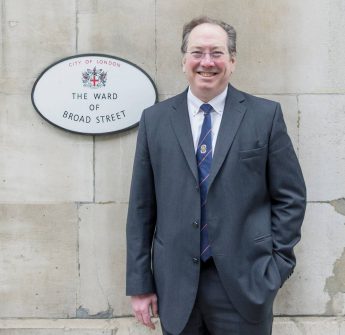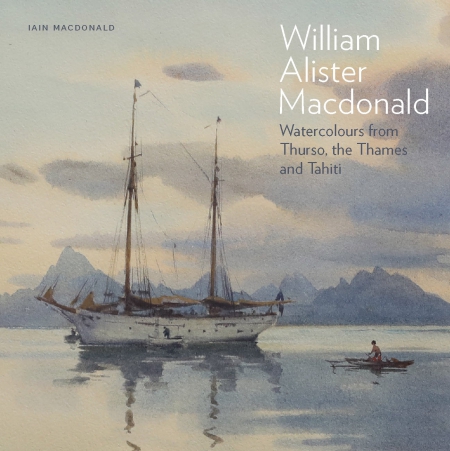Elisabeth and I like the artist William Alister Macdonald a lot, having chosen his work to grace our invitation cards celebrating our connections with the Thames and Thames sailing barges. But there is a frisson of imposter syndrome when you’re asked to write a foreword to a book for an artist you like a lot, but on whom you are no expert. Such was the case when Ian Macdonald asked me to provide a foreword for his book about his great-great-uncle William Alister Macdonald.
William Alister Macdonald (1861–1956), the ‘Tahitian Turner’, was an artist renowned for his luminous watercolours and atmospheric landscapes. Born in Clyne, Sutherland, he took a job at London & Westminster Bank in Lothbury in 1880 and attended night school at St Martin’s School of Art. He left the bank in 1884 for full-time painting and travel, eventually gaining recognition for his evocative depictions of the Thames and the South Pacific, particularly Tahiti. His travels deeply influenced his style, blending the romanticism of JMW Turner with the vibrant colours and light of the tropics. Macdonald’s work stands out for its emotional depth and painterly sensitivity, earning him a unique place in both Scottish, English, and Polynesian art traditions.
My foreword read as follows:
“It is with great pleasure that I introduce this comprehensive biography of the Scottish watercolourist, William Alister Macdonald, penned by Dr Iain Macdonald. The story of Macdonald’s life and his artistic journey offers an extraordinary glimpse into a bygone era, capturing the essence of London’s streets and the Thames’ vibrant river life at the turn of the last century.
William Alister Macdonald’s works, particularly those in the remarkable Wakefield Collection, hold a special place in the Guildhall Art Gallery. Donated by Lord Wakefield in 1935, these watercolours are not only artistically exquisite but also of immense historical significance. They document the atmospheric beauty of London from Kew to Rotherhithe, including iconic views of Westminster, the Temple, and St. Paul’s Cathedral. Macdonald’s ability to convey the colours and moods of these scenes has ensured his work remains an invaluable asset to our cultural heritage.
In 2001, the Guildhall Art Gallery proudly exhibited Macdonald’s watercolours alongside contemporary photographs, highlighting the dramatic transformation of London over the past century. This juxtaposition underscored the lasting impact of Macdonald’s artistry and the importance of preserving such works for future generations.
The Lady Mayoress and I recently had the honour of selecting Macdonald’s work from the Gallery’s collection to grace our invitation cards. We hold a great appreciation for Macdonald’s contribution to the arts and his unique ability to capture the spirit of the City of London.
I commend Dr Iain Macdonald for his meticulous research and dedication in bringing this important artist’s story to life. May this book inspire a renewed appreciation for William Alister Macdonald’s legacy and his contribution to the world of art.”
Macdonald’s paintings are part of the Wakefield Collection at the Guildhall Art Gallery.
The Wakefield Collection, Donated 1911-1939
Charles Cheers Wakefield was Lord Mayor of London in 1915. As a philanthropist and wealthy oil industrialist, he contributed funds to many charitable causes including The Wakefield Trust, which was set up in his name by Lady Wakefield and continues to operate today. Wakefield supported the Guildhall Art Gallery from 1911 onwards through subscriptions and commissions.
Works acquired by the Gallery with his help include Sir George Frampton’s bust of Queen Mary, sculpted as a companion to Frampton’s bust of George V, and Holman Hunt’s The Eve of St Agnes. In 1927, Wakefield presented the Gallery with Millais’s 1849 watercolour version of Lorenzo and Isabella and another royal bust, King Edward VII by Albert Bruce Joy. Between 1936 and 1939 he gave the Gallery its collection of London watercolours by William Alister Macdonald, Henry Pether’s Gun Wharf, Tower of London, David Roberts’ small watercolour The Lord Mayor’s Show at Westminster and a specially commissioned painting by Frank Salisbury, Coronation Luncheon at Guildhall, 1937: The Toast to the King. The Wakefield collection also includes Sir Peter Lely’s portraits of Sir Edward Hales and his family, Sir Joshua Reynolds’ Pope Paviarius and JMW Turner’s delicate watercolour view of Hythe, Wakefield’s adopted home town.

